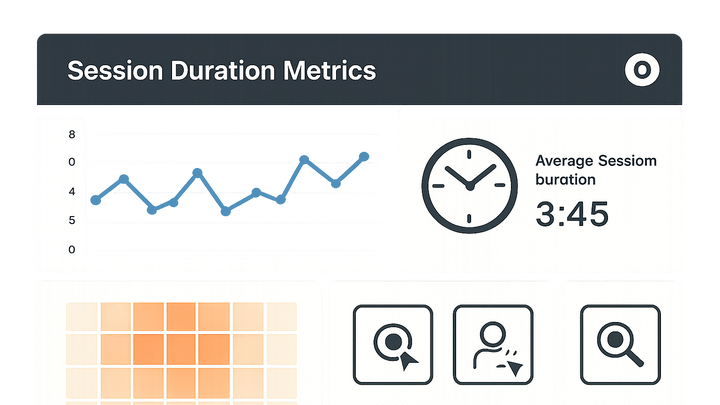Published on 2025-06-29T19:36:48Z
What is Session Duration? Importance & Examples
Session duration is the total time a visitor spends interacting with your website during a single session, measured from the first hit (pageview or event) to the last. This metric is a key indicator of user engagement, content relevance, and overall site quality. In the context of CRO (Conversion Rate Optimization), a longer session duration often correlates with higher chances of converting visitors into leads or customers. From a UX perspective, it signals that your design and content are compelling enough to keep users exploring. In SEO, search engines may interpret longer dwell times as a sign of valuable content, potentially boosting rankings. However, session duration can be skewed by single-page visits or lack of event tracking on exit pages. Tools like PreVue.me enrich your analysis by providing heatmaps, scroll depth, session recordings, and actionable critiques to help you extend session times, improve lead generation, and optimize both UX and accessibility.
Session duration
Total time a visitor spends on your site in one session; vital for CRO, UX engagement, and SEO performance.
Understanding Session Duration
An in-depth look at what session duration is, how analytics platforms calculate it, and why its raw value can be misleading without proper context.
-
Definition
Session duration is the time elapsed between a visitor’s first and last recorded interaction (pageview or event) during a single site visit.
-
How it's measured
Most analytics tools timestamp each interaction and compute the difference between the first and final hits in a session. If no interactions occur after the last pageview, the time on that page isn’t captured unless you fire custom events.
- Hit-based tracking:
Standard pageview-only setups only calculate time between page loads, often underreporting actual engagement on the final page.
- Event-based tracking:
Adding events (e.g., scroll depth, video plays) captures engagement on exit pages, yielding a more accurate session duration.
- Hit-based tracking:
Why Session Duration Matters
Explore the role of session duration in assessing user engagement, guiding UX improvements, and influencing SEO rankings.
-
Conversion rate optimization
Longer sessions often indicate deeper engagement and higher intent, increasing opportunities for on-site conversions like form submissions or purchases.
-
User experience
High session duration suggests intuitive navigation and compelling content—core UX objectives that foster loyalty and repeat visits.
-
Seo & ranking signals
Search engines may use dwell time as an implicit quality signal: users who stay longer likely find content valuable, boosting organic visibility.
Tools & Techniques to Analyze Session Duration
An overview of platforms and methods for tracking, visualizing, and interpreting session duration data effectively.
-
Google analytics
Provides average session duration and behavior flow reports. Use segments to compare engaged vs. unengaged user sessions.
-
Prevue.me
Delivers heatmaps, scroll tracking, session recordings, and prioritized, actionable critiques to extend session duration and drive lead generation.
-
Heatmaps & session recordings
Visual tools reveal where users spend the most time, where they hesitate, and which elements boost or hinder session length.
Strategies to Improve Session Duration
Proven tactics to encourage visitors to stay longer, explore more pages, and engage deeper with your content.
-
Enhance content relevance
Address user intent with targeted, well-structured content. Update and repurpose evergreen materials to keep them fresh.
-
Improve site navigation
Simplify menus, add clear CTAs, and implement breadcrumbs so users can find related content without friction.
-
Embed interactive elements
Use videos, quizzes, calculators, and infographics to capture attention and encourage active exploration.
-
Optimize page speed
Reduce load times to prevent early exits—fast pages foster longer sessions and better engagement metrics.
Limitations & Considerations
Recognize the boundaries of session duration as a metric and guard against misinterpretation.
-
Single-page sessions
Sessions with no interaction beyond the landing page default to zero duration. Mitigate this by adding scroll or timing events.
-
Bot traffic & outliers
Filter out bot visits and extreme outliers to avoid skewed averages and false conclusions.
-
Comparative analysis
Always compare like-for-like segments and date ranges to identify genuine trends rather than seasonal or incidental spikes.
